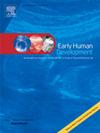危重先天性心脏病患儿心肺健康、活动行为、身体素质和父母运动参与之间的关系
IF 2
3区 医学
Q2 OBSTETRICS & GYNECOLOGY
引用次数: 0
摘要
目的:探讨危重型先天性心脏病(CCHD)患儿心肺健康(CRF)、活动行为(即体力活动和运动参与)、身体素养(动机、信心、知识和理解)和父母运动参与的关系,并探讨单心室生理(SVP)患儿和双心室生理(BVP)患儿的差异。方法:90例CCHD患儿(中位年龄10.0[7.0-13.0]岁)参与本前瞻性观察研究。通过心肺运动试验(vo2峰值)测量CRF。活动行为、身体素养和父母的运动参与使用有效的问卷进行评估。结果:CRF与体力活动呈正相关(r = 0.36, p)。结论:CRF与CCHD患儿体力活动、动机和信心呈正相关。此外,父母的体育参与与孩子的体育参与有关。这些发现建议在干预措施中结合身体素养和以家庭为中心的方法,旨在提高CCHD儿童的CRF。本文章由计算机程序翻译,如有差异,请以英文原文为准。
Associations between cardiorespiratory fitness, activity behavior, physical literacy and parental sports participation in children with a critical congenital heart disease
Objective
This study investigated associations between cardiorespiratory fitness (CRF), activity behavior (i.e. physical activity and sports participation), physical literacy (motivation, confidence, knowledge and understanding), and parental sports participation in children with critical congenital heart disease (CCHD), and explore differences in children with a single ventricle physiology (SVP) and children with biventricular physiology (BVP).
Methods
Ninety children with CCHD (median age 10.0 [7.0–13.0] years) participated in this prospective observational study. CRF was measured through cardiopulmonary exercise testing (VO₂peak). Activity behavior, physical literacy, and parental sports participation were assessed using validated questionnaires.
Results
CRF was moderately associated with physical activity (r = 0.36, p < .001) and weakly associated with motivation and confidence (r = 0.25, p = .019). No association was found between CRF and sports participation. Children's sports participation was positively associated with maternal (r = 0.23, p = .034) and paternal (r = 0.23, p = .042) sports participation, as well as with motivation and confidence (r = 0.28, p = .009). Children with a SVP (n = 11) had significantly lower CRF than those with BVP (n = 79) (p < .001). No other differences were found between children with a SVP and children with a BVP.
Conclusion
CRF is positively associated with physical activity, motivation and confidence in children with CCHD. Additionally, parental sports participation is associated with children's sports participation. These findings suggest integrating a physical literacy and family-centered approach in interventions aimed to enhance CRF in children with CCHD.
求助全文
通过发布文献求助,成功后即可免费获取论文全文。
去求助
来源期刊

Early human development
医学-妇产科学
CiteScore
4.40
自引率
4.00%
发文量
100
审稿时长
46 days
期刊介绍:
Established as an authoritative, highly cited voice on early human development, Early Human Development provides a unique opportunity for researchers and clinicians to bridge the communication gap between disciplines. Creating a forum for the productive exchange of ideas concerning early human growth and development, the journal publishes original research and clinical papers with particular emphasis on the continuum between fetal life and the perinatal period; aspects of postnatal growth influenced by early events; and the safeguarding of the quality of human survival.
The first comprehensive and interdisciplinary journal in this area of growing importance, Early Human Development offers pertinent contributions to the following subject areas:
Fetology; perinatology; pediatrics; growth and development; obstetrics; reproduction and fertility; epidemiology; behavioural sciences; nutrition and metabolism; teratology; neurology; brain biology; developmental psychology and screening.
 求助内容:
求助内容: 应助结果提醒方式:
应助结果提醒方式:


